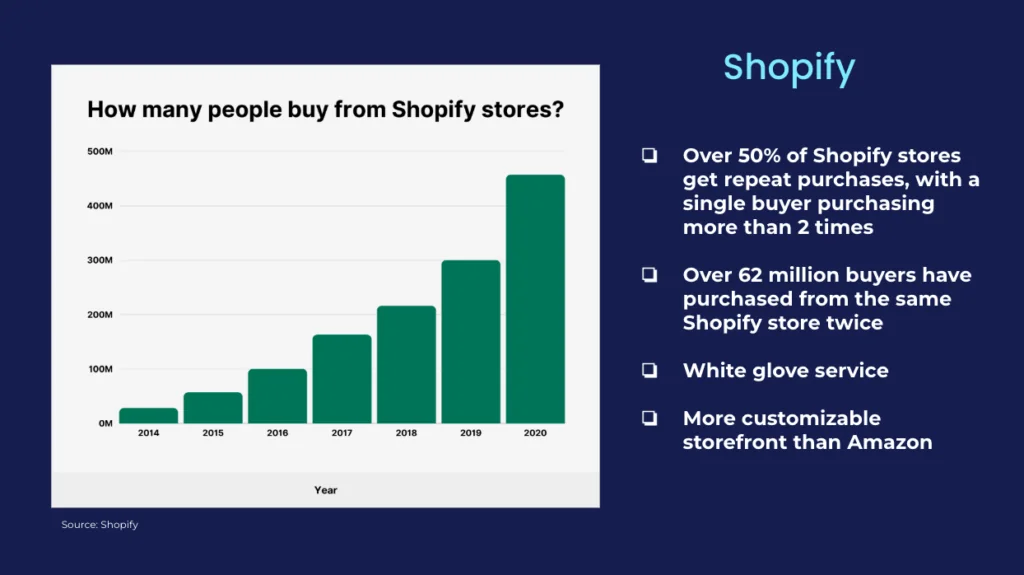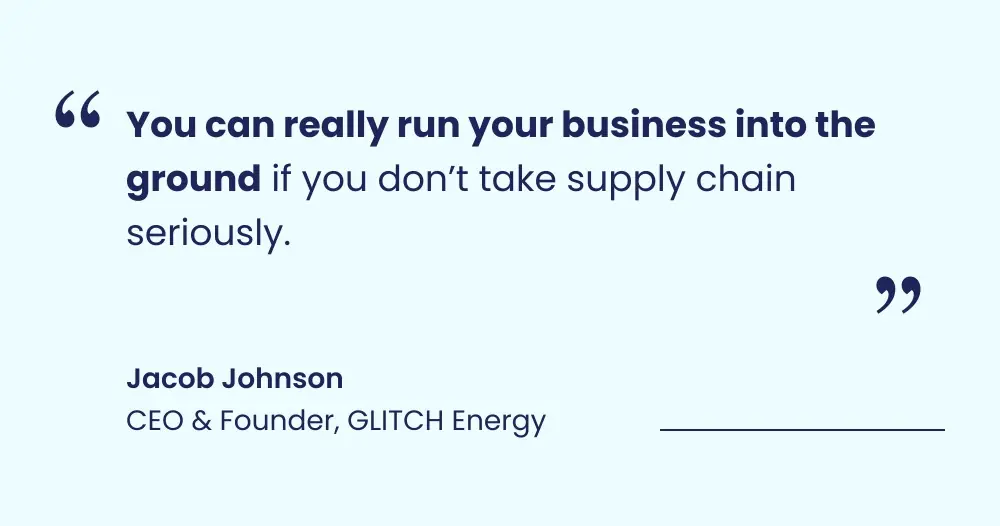Webinar: Amazon vs Shopify—which is better for your ecommerce store?
Amazon and Shopify are two of the prime eCommerce marketplaces in the world today. In 2021, these platforms saw a GMV (Gross Merchandise Valuation) of $390 billion and $175 billion, respectively. They present the best ecosystems for new companies that aspire to create successful online stores. In today’s webinar, we talk to eCommerce veterans David Lang and Ryan Sherrard of DAVAN Strategic and Jacob Johnson of GLITCH Energy. They open up about their experiences with Amazon and Shopify and share the hard-earned wisdom they picked up on the way.
Amazon vs Shopify: Starting Your Store
Jacob found that Shopify’s platform made it the best option for him to get started with. His project for GLITCH was built upon already having a large audience. It was provided by his partner, Tyler, who has a Youtube gaming channel with 8 million subscribers. Given these circumstances, Shopify offered the most streamlined way to establish a successful online store.
On Shopify’s platform, sellers have much more control over how their store looks than on Amazon. Jacob found that his initial focus on making the coolest-looking website possible was of secondary importance. The priority should have been making sure it had an engaging CTA (Call To Action) and clear ‘buy’ buttons. He experienced a steep learning curve in understanding all of this. Jacob found that onboarding with Shopify Plus wasn’t the best choice as it cost a lot and didn’t provide enough advantages at that stage. Eventually, he consulted with a launch engineer, who walked him through the whole process. Shopify’s many customization options offer lots of potential but come with several challenges.

When David started DAVAN, he had no background in eCommerce. This made him wary of designing a website on his own. He liked the perks Amazon FBA (Fulfillment By Amazon) offered, such as not needing to hire employees or create a website. Its massive marketplace, comprising 37.8% of eCommerce market share, was also extremely tempting. When his first product failed, he turned his focus to Amazon’s algorithm. David says that a good understanding of it can make a massive difference in your store’s Amazon ranking.
Ryan feels that eCommerce newcomers that don’t have the kind of following Jacob started with might find Amazon’s space more favorable. In his opinion, “The barrier to entry is much lower. You’re bringing your product to Amazon, and Amazon is then bringing the customer to you.” David points out that it gives very few customization options for your store’s pages. Being able to tailor your website gives you a better ability to explain what your product is all about.
Question: What advice do you have for sourcing products/finding the best product for Amazon?
From Ryan’s experience, it’s very important that you choose a product that already has a solid search volume and keyword ranking before investing in it. His first product was well-made and high-quality but still failed. Consumers weren’t searching for the relevant keywords. So Ryan targeted broader terms, which were more loosely related to the product, with ads. This led to a terrible conversion rate because of his ads’ low relevance.
His experience led Ryan to put a massive emphasis on keyword research. Online sellers starting out on Amazon should invest heavily in this to kickstart their project, according to him. There are many tools out there that help with this, such as JungleScout, Helium10, and ZonGuru.
He also offered a free way to do this kind of research: If, for example, you search for a shower floor mat on Amazon, and you see that the first results page shows you something irrelevant, such as a sponge or towel, this demonstrates there is room for you to insert yourself. That means if you decide to sell shower floor mats, you should be able to edge out that less relevant product with moderate effort. Less relevant products showing up on the first results page are a good indicator that this sector hasn’t been oversaturated yet, and has room for more competition.
Amazon vs Shopify: Marketing
Many new stores start their marketing with Amazon PPC (Pay Per Click), according to Ryan. It offers a variety of campaigns and ad types that can help establish a brand. Even today, Amazon PPC is still 80-90% of DAVAN’s advertising focus. Amazon makes it particularly hard to track external traffic coming to the site, making it hard to tell if your Google or Facebook ads are converting or not. With Amazon PPC you get all the data right on your dashboard. Ryan finds that it has become increasingly necessary. With the surge of sponsored products, it’s very hard to stand out if you don’t participate.
The collective drive by companies to get their products to the top rankings has raised the price of Amazon PPC campaigns. While being ranked in the top 10 or 30 listings of a certain product used to feel like a big achievement to Ryan, that’s no longer the case. Being in the top 10 might mean your product is halfway down page 1. Being in the top 30 might mean you’re on page 2. This placement has a huge impact on sales. David adds that this isn’t necessarily a bad thing. New sellers that are just starting out can have a seat at the table from day 1 this way.
For most eCommerce brands launching on Shopify, paid media is around 80% of their marketing budget. It’s what helps them start to scale. GLITCH, achieved its growth via its Youtube partner, by targeting their audience. Jacob tested different campaigns, with the goal of converting this audience to their channel through email, SMS, and social media. He also sent PR boxes, with samples of his product, to other Youtube creators. This generated a lot of organic impressions.
Creating organic content on TikTok is a good strategy for new sellers starting out on Shopify, which is where GLITCH got a lot of traction. TikTok also gives fast feedback on how engaging content is, meaning you quickly know where to spend media dollars. Jacob recommends doing a lot of research about TikTok trends and how to integrate your product into them, posting as much as possible, and then analyzing your performance.
Conversions on Amazon are so high because people come to the platform, already wanting to buy products, in David’s view. Conversely, since people don’t necessarily want to buy something on TikTok, ads often annoy them. On Amazon, ads have a positive purpose, by helping consumers with their decision to buy, making them much more receptive. Ryan says it is for this reason that brands should focus on organic placement so that their audience doesn’t necessarily know it is being advertised to.
Final Round: Amazon VS Shopify: Supply Chain

Having an audience and a market to sell a product in is important, but the supply chain is just as crucial, if not more. Jacob believes that “you can really run your business into the ground if you don’t take supply chain seriously.” When it comes to Shopify, which doesn’t have an equivalent to Amazon Fulfillment, sellers need to decide what they can do in-house. Operating and shipping from your apartment becomes much less feasible once you start to scale. Internal fulfillment might give you a lot of control, but leasing a warehouse can become a huge commitment.
Jacob faced a steep learning curve regarding his supply chain. He had to find a 3PL (third-party logistics) and shipping service that would connect to his Shopify store. Even though he partnered with ShipBob, integrating it with other 3PLs and his warehouse management system was still a complicated process.
To David, working with Amazon is a similar experience. Managing a supply chain is the same for most sellers. He recommends joining FBA since it means the same service provider is shipping products and taking care of customers. Another benefit is that you can easily scale from being a small seller to a big one since Amazon is equipped to service both. A different fulfillment partner might not have that capability, meaning you’ll need to switch once your sales volume reaches a certain level.
To Ryan, Amazon FBA comes with pros and cons. The upside is that they handle storing, packing, shipping, and returns, but relinquishing this control can also be a bad thing. To him, Amazon isn’t always very transparent about where inventory is and why it might be taking longer to arrive. This can cause some headaches. Here David adds, that one major benefit of FBA is the Prime badge. While customers might not trust every brand, they have immense trust in Amazon since it has a great track record in taking care of them. If a customer wants to return an item they can do so with no questions asked.
David recalls a mistake he made with Amazon: in order to reduce complexity he sent all his units to its warehouses. But when sales performed worse than expected he faced large storage fees, which are steeper on Amazon than elsewhere. If you keep goods with them for too long, you also get charged extra. For this reason, David strongly recommends using a 3PL.
When it comes to setting up a supply chain, Jacob advocates prioritizing efficiency over pricing. It is usually wise to choose a supplier that can offer lower minimum order quantities, with better lead times, and better terms, over a cheaper alternative. Being set up with a good supplier that can handle more orders when you scale is a great asset. It also means you can deepen the relationship as you grow, resulting in better conditions and rates, potentially. Small savings with a cheaper supplier can cause much bigger losses from shipping delays, or bad reviews and returns due to lacking product quality.